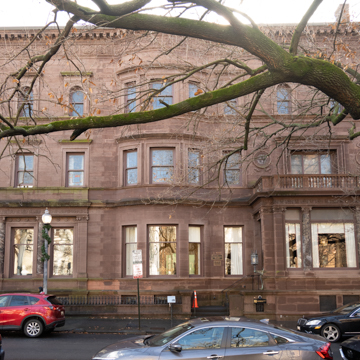The most imposing town house on Mount Vernon Place was built for Robert Garrett, president of the Baltimore and Ohio (B&O) Railroad. Its plan was so massive that a court battle ensued to prevent its construction, arguing that its Renaissance Revival style, while appropriate for New York City, was not in keeping with conservative Baltimore. The vestibule alone measures 20 × 24 feet and adjoins a portico that projects onto the sidewalk. Its lavish interior décor is among the grandest in Baltimore. Garrett’s widow and her second husband, physician Henry Jacobs, added a large ballroom in 1905, later enhancing the gallery space, and eventually incorporating the adjoining house. In the 1940s, the house was used by various organizations and is currently owned by the Engineers Club of Baltimore. It remains the largest town house ever built in Baltimore.
You are here
GARRETT-JACOBS HOUSE
1884–1893, McKim, Mead and White; c. 1905; 1909–1913 additions, John Russell Pope. 7–11 W. Mount Vernon Pl.
If SAH Archipedia has been useful to you, please consider supporting it.
SAH Archipedia tells the story of the United States through its buildings, landscapes, and cities. This freely available resource empowers the public with authoritative knowledge that deepens their understanding and appreciation of the built environment. But the Society of Architectural Historians, which created SAH Archipedia with University of Virginia Press, needs your support to maintain the high-caliber research, writing, photography, cartography, editing, design, and programming that make SAH Archipedia a trusted online resource available to all who value the history of place, heritage tourism, and learning.


